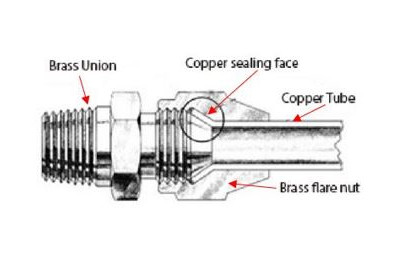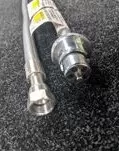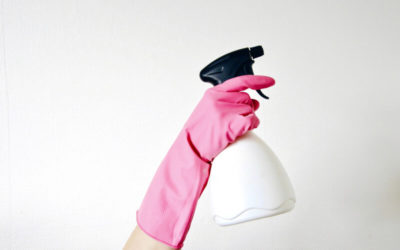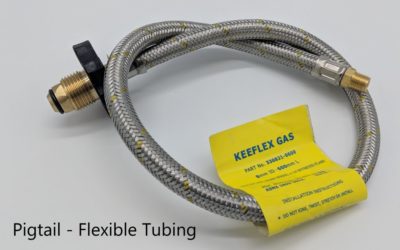How to Measure and Identify Gas Fittings in Australia Simply
When it comes to gas fittings in Australia, understanding how to measure and identify the right components is essential for ensuring a safe and efficient setup. After all, measuring gas fittings using the imperial scale can be confusing.
For caravan enthusiasts, motor home owners, and camper trailer adventurers, the variety of different threads available can make it tricky to choose the correct fittings. To ensure your gas system connects properly and functions smoothly, you often need specific gas fittings.
A fully qualified Gas Fitter wrote this guide to provide you with the detailed information you need to confidently order the correct components for your gas system. Whether you’re looking to install or replace fittings, the advice provided here will simplify the process, giving you peace of mind that you’re making the right choices.
However, keep in mind that this information serves as a general guide only. For specific advice or installations, always consult a professional Gas Fitter to ensure compliance with Australian safety regulations. Proper identification and measurement of gas fittings are crucial for the safety of your setup.
Please note, it is a requirement that only Licensed Gas Fitters can legally install gas components in Australia, except for portable appliances. This is essential to ensure compliance with Australian safety regulations and prevent any hazards associated with improper installation.
BSP (British Standard Pipe) Threads for Gas Fittings
BSP (British Standard Pipe) threads are one of the most commonly used thread types. Whether you’re working on a caravan, motor home, camper trailer, or any other gas-powered system, understanding BSP threads is crucial for selecting the right components and ensuring a secure and safe connection.
One important thing to know is that straight BSP threads are tapered and also require a sealant for proper installation. Use liquid-type sealants like Loxeal or thread tape such as Yellow PTFE (Teflon) to create a leak-proof seal. This is especially vital for gas applications, where safety is the top priority.
When it comes to gas thread sizes, it’s important to note that these sizes rarely correspond to the actual physical measurement of the thread itself. Instead, they mostly refer to tube or bore sizing, making it necessary to measure the thread carefully before selecting the right component.
To correctly measure BSP threads:
- For male threads, as the thread is tapered you need to find the average diameter by measuring the outside diameter (O.D.) at several points along the thread.
- For female threads, measure the inside diameter (I.D.).
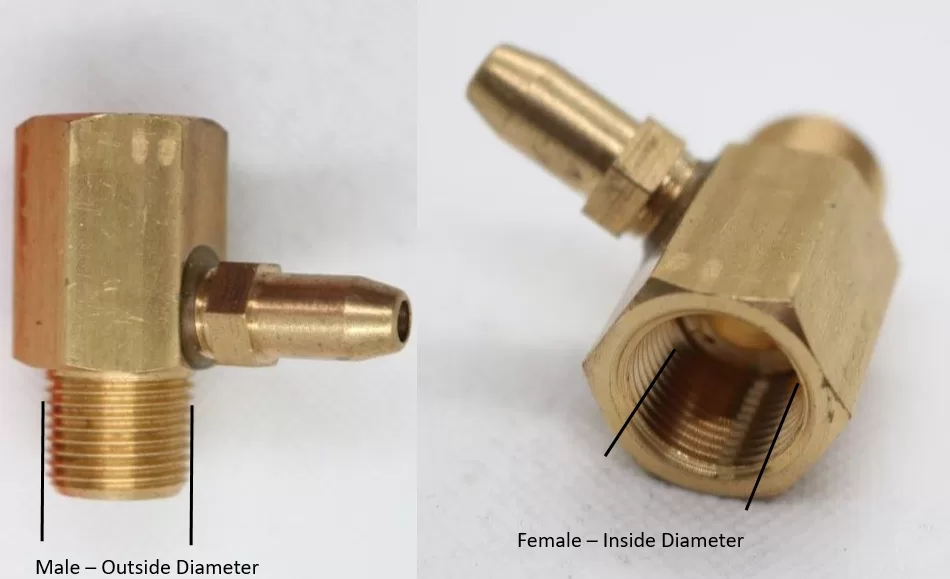
Once you’ve taken these measurements, you can refer to the appropriate size guides to determine the correct thread size for your needs. Keep in mind that all BSP thread sizes are approximate, so accuracy is essential when identifying the right components for your gas system.
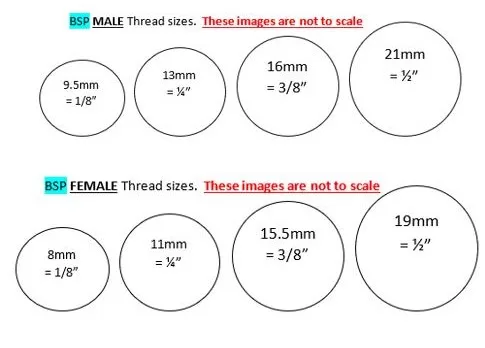
By following these steps, you’ll be able to confidently measure and identify BSP threads for any gas fitting project.
SAE 45 Degree Flare Fittings for Gas Systems
The SAE 45 Degree Flare fittings are widely used in gas systems for caravans, motor homes, and camper trailers. These fittings are easy to identify, especially the male fittings, which feature a distinctive 45-degree flare at the end. These flared fittings screw into either a flare nut at the end of a copper pipe or a swivel nut on a gas hose.

Key Features of SAE 45 Degree Flare Fittings:
- 45 Degree Flare: The hallmark feature of SAE flare fittings.
- Female Flare: This is the complementary thread to the male parallel thread, used in gas hoses and systems.
- Swivel Nut: Often found on gas hoses, allowing for easy connection with the male fitting.
When you use these fittings with copper pipes, the copper tube is flared to 45 degrees, allowing the brass flare nut to compress the copper section against the brass union. This compression creates a tight, reliable seal between the copper and brass surfaces. These fittings do not require or allow thread sealant, as the flare design ensures a leak-proof connection.
Components and Measurements:
- Brass Union: This connects the flared copper pipe to the fitting.
- Copper Sealing Face: The copper pipe’s flared end that forms the seal.
- Copper Tube: The tube flares at 45 degrees to connect with the fitting.
- Brass Flare Nut: Tightens the connection between the copper tube and the fitting.
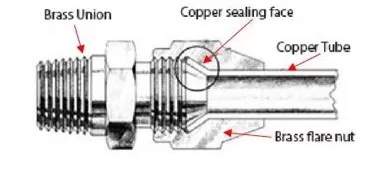
You can measure the inside and outside diameters of the thread, similar to BSP fittings, to determine the correct size. Refer to the size guides below for accurate identification of SAE flare thread sizes:
SAE Flare Male and Female Thread Sizes (Approximate):

Caravans, motorhomes, and camper trailers most commonly use 3/8″ or 5/16″ copper pipe, with the occasional 1/2″ size. It’s important to ensure you are selecting the correct size for your system to guarantee a safe and efficient connection.
POL Fittings (Prest-O-Lite) for Gas Cylinders
POL fittings, or Prest-O-Lite fittings, commonly connect gas systems that use larger gas cylinders, including the 4.5kg, 9kg, and other larger sizes. These fittings are a standard in Australia, ensuring secure connections to gas cylinders in caravans, motorhomes, and other gas-powered systems.
Key Features of POL Fittings:
- POL Female Fittings: These fittings connect to gas cylinders and feature a left-hand thread, meaning they tighten in the opposite direction of most standard fittings.
- No Thread Sealant Required: Like other gas fittings such as SAE and inverted flares, POL fittings do not require or allow any thread sealant. This is due to the secure sealing mechanism of the fitting itself.
- Rubber O-Ring on Male POL Fittings: Many male POL fittings feature a rubber O-ring that creates a tight seal when connecting to the female fitting It’s important not to over-tighten these fittings, as doing so can damage the O-ring and compromise the connection.
- Pigtail Connections: In many setups, the POL fitting connects with a copper pigtail to link the cylinder to the gas system. Some POL fittings use solid brass, which may need a tighter connection to ensure a secure fit.
Types of POL Fittings:
- Rubber O-Ring POL Fittings: These fittings rely on the O-ring to create a seal and should tighten only until you achieve a secure connection.
- Solid Brass POL Fittings: These require more torque to ensure the fitting is tight enough to prevent leaks. Unlike O-ring fittings, the solid brass version needs to be very tight to form a proper seal.
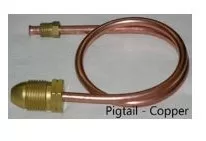
Understanding the differences in POL fittings and how to correctly install them is crucial for ensuring a safe gas connection. Since you commonly find these fittings on larger gas cylinders, following the proper guidelines is important to prevent any issues.
LCC27 Fittings
The LCC27 fitting is a newer gas cylinder connection standard introduced in Australia to replace the traditional POL (Prest-O-Lite) fitting over time. This safety-enhanced fitting aims to improve the overall safety and ease of use when connecting gas cylinders to appliances, especially for portable LPG setups like those in caravans, motorhomes, and outdoor appliances.
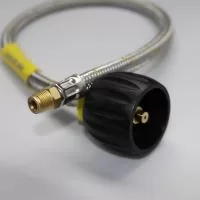
Key Features of LCC27 Fittings:
- Right-Hand Thread: Unlike the POL fitting, which uses a left-hand thread, the LCC27 features a right-hand thread, making it more intuitive for most users to connect and disconnect.
- Safety Mechanism: LCC27 fittings include a built-in safety valve that prevents gas from escaping unless you secure the connection properly. This feature reduces the risk of accidental gas leaks during connection or disconnection.
- No Thread Sealant Required: Like POL fittings. LCC27 fittings do not require or allow thread sealant, as they rely on their internal sealing mechanism to ensure a gas-tight connection.
- Compatibility with POL Cylinders: While LCC27 fittings serve as the future standard. They also remain backward compatible with older POL gas cylinders, enabling users to transition gradually. But be aware that whilst the POL connector from your pigtail is compatible with the new LCC27 LPG bottles, the new LCC27 connector is not compatible with the old style POL LPG bottles.
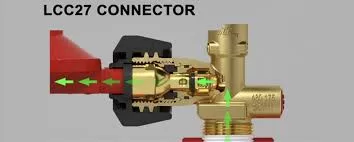
Benefits of LCC27 Over POL Fittings:
- Enhanced Safety: With the built-in safety valve, LCC27 fittings significantly reduce the risk of gas leaks. Making them a safer option for domestic and recreational gas systems.
- User-Friendly: The right-hand thread design and easy-to-use mechanism make LCC27 fittings simpler and more intuitive to handle, reducing the risk of improper connections.
Where LCC27 Fittings Are Used:
- Portable LPG Systems: Ideal for use with gas appliances in caravans, camper trailers, and motorhomes.
- BBQ and Outdoor Gas Appliances: Perfect for connecting to BBQs and other outdoor gas appliances for home or recreational use.
- Larger Gas Cylinders: People commonly use LCC27 fittings with the same cylinders that previously used POL, including 4.5kg and 9kg LPG cylinders.
By adopting the LCC27 fitting for your gas systems, you ensure compliance with the latest safety standards while enjoying a more secure and user-friendly connection.
3/8″ Left Hand Gas Cylinder Threads
These threads are used across various brands, including Companion, Gasmate, Cougar, Cook-on, and Kookaburra.
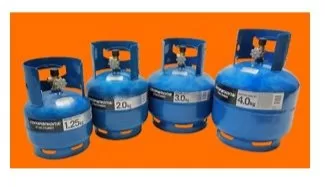
3/8″ Left Hand threads are designed for specific gas appliances to ensure a secure connection. The left-hand thread allows you to make the connection by turning counterclockwise, which prevents accidental disconnections during operation. Brands like Companion, Gasmate, Cougar, Cook-on, or Kookaburra may have models that require specific 3/8″ Left Hand threads. So it’s important to know what you’re looking for.
Using the correct gas cylinder thread is critical for safety. A mismatch can lead to gas leaks or inefficient operation. Always check the specifications of your equipment to ensure compatibility with 3/8″ Left Hand threads.
Primus Gas Cylinders and Connections
Primus gas cylinders feature a proprietary connection designed for exclusive use with Primus-style valves. This unique system ensures a secure and efficient flow of gas, specifically tailored for Primus appliances.
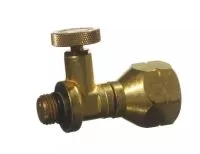
- Proprietary Connection: You cannot use standard fittings with Primus cylinders. They require a specific valve designed for compatibility, ensuring safe operation.
- Secure Gas Flow: Gas flows only when you fully screw the Primus valve fitting into the cylinder. This design prevents leaks and ensures a tight, secure connection before releasing gas.
- Safety First: The proprietary design not only enhances functionality but also prioritizes user safety. Always check that you properly connect the valve before operating your Primus appliance.
When using Primus cylinders, always follow manufacturers guidelines.
Bayonet Fittings
Bayonet fittings are essential components for removable gas appliances, providing a safe and efficient way to connect and disconnect gas lines. These fittings feature a self-sealing mechanism that ensures a secure connection without the risk of gas leaks.
Key Features of Bayonet Fittings
- Easy Connection: To connect a bayonet fitting, simply push the hose into the socket and turn it clockwise 90 degrees. This quick and straightforward method allows for effortless setup and pack up of your gas appliances.
- Self-Sealing Design: The 1/4 turn isolation valve in bayonet sockets means that they seal automatically when disconnected, enhancing safety by preventing gas leaks when the appliance is not in use.
- Standardized Size: In the caravan industry, all bayonet sockets come in a single standardized size. Simplifying compatibility and making it easier for users to find the right fittings for their needs.
Importance of Bayonet Dust Plugs
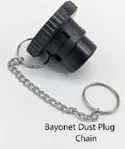
To maintain the integrity of your gas connections, always use a bayonet dust plug whenever you unplug the hose. Here’s why:
- Prevent Contamination: A plastic dust plug prevents foreign objects from entering the hose and appliance, which can cause clogs and hinder performance.
- Enhance Safety: Keeping the connection sealed when not in use. Minimising the risk of accidental gas leaks and ensures a clean connection for future use.
Quick Connect Couplings
Quick Connect Couplings are an excellent solution for easily disconnecting hoses from appliances. Making them ideal for storage or for connecting stowable appliances in compliance with Australian standards.
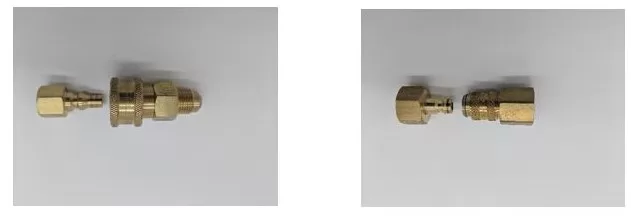
Key Features of Quick Connect Couplings
- User-Friendly Design: Connecting and disconnecting is straightforward. Simply push the coupling in to connect, and when it’s time to disconnect, pull back the sleeve. This operation is reminiscent of an air hose system, ensuring intuitive use.
- Space-Saving Convenience: Quick Connect Couplings allow for easy removal of hoses, which is perfect for stowable appliances. This feature particularly benefits outdoor cooking setups and caravans where space is limited.
- Safety Compliance: These couplings meet Australian standards, ensuring that your connections are not only efficient but also safe for use in various applications.

Benefits of Using Quick Connect Couplings
- Rapid Setup: Quick Connect Couplings facilitate fast and hassle-free connections. Allowing you to get your appliances ready for use in no time.
- Durability: Designed to withstand the rigors of outdoor use, these couplings are robust and reliable, ensuring a long-lasting connection.
- Versatility: Quick Connect Couplings work well with various types of gas appliances, enhancing their utility.
